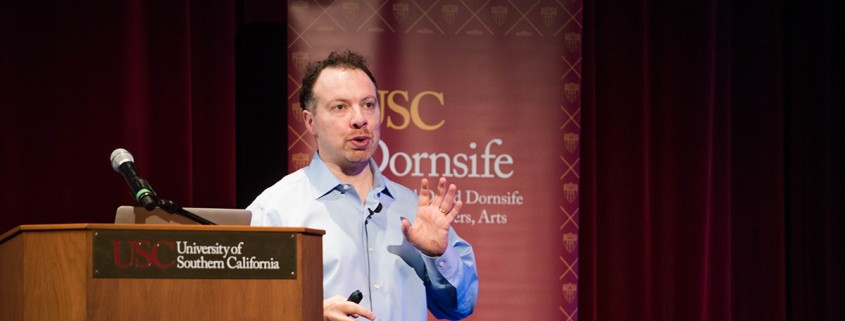Nobel laureate discusses astrophysics, cosmology
Many scientists now believe that the universe is expanding at an accelerating pace, but this phenomenon was first discovered by Adam Riess, a Nobel Prize-winning astrophysicist. Riess spoke at Bovard Auditorium on Monday about measurements of distant supernova that led to his discovery as part of the USC Dornsife Irene McCullouch Distinguished Lecture series.
“The reason I got into this field was to answer profound questions like when did the universe begin,” Riess said. “I wanted to devise and perform real science experiments to answer these.”
Riess has held the Bloomberg Distinguished Professorship, the Thomas J. Barber Professorship of Physics and Astronomy and the Krieger-Eisenhower Professorship of Physics and Astronomy at Johns Hopkins University. He is also a senior member of the science staff at the Space Telescope Science Institute.
Along with Brian Schmidt and Saul Perlmutter, Riess received the 2011 Nobel Prize in Physics for providing evidence that supported the phenomenon. The scientists were also awarded the 2015 Breakthrough Prize in Fundamental Physics and shared the $1 million Shaw Prize in Astronomy in 2006. Along with his other awards, Riess was also honored with the Albert Einstein Medal in 2011 and the 2008 MacArthur Fellowship.
According to Riess, one of the most important unsolved problems in cosmology and astrophysics is understanding the unexplained and mysterious nature of dark energy. While discussing the discovery of the accelerating universe, Riess explained that the farther away a galaxy is from us, the faster it will appear to recede.
“The key is to measure how far away the galaxies are and how fast they recede from us,” Riess said. “In particular, measuring distance is the hardest thing to do in space.”
The distances on earth are measured using various methods such as parallax, lighthouses, foghorns and objects of known size. However, these methods involve human creations, so in space, distance measurement uses the standard candle approach.
“A galaxy has millions of stars that have known luminosity and can be used as standard candles,” Riess said. “When one of these stars explodes, it could be as bright as 4 billion times the luminosity of the sun. In addition, the inverse square law states that intensity is inversely proportional to the square of the distance from the source of that physical quantity.”
The other property that Riess and his team needed to measure is the speed at which the galaxies are rushing away from the earth. They did so by looking at the nature of the light coming from distant objects.
“A supernova emits light at known wavelengths, and because of the expansion of space, the wavelengths are stretched [and] it gets redder,” Riess said. “This redshift measures the apparent recession velocity of the galaxies.”
The Hubble Constant, H0, which is the measured slope or the linear relation between the velocity and distance, gives the present expansion rate of the universe. If the universe would contract instead of expand, then this slope would be negative.
According to Riess, we can measure that expansion rate by using the Hubble Constant. By taking the inverse of the rate, the approximate age of the universe can be calculated.
“It is not very likely to stare at one galaxy and find a supernova,” Riess said. “However, if you stare at 100 galaxies for one year, you are likely to see a supernova, and if you stare at 1,000 galaxies, you will see 10 supernovae in a year.”
Riess studied four supernovae in his thesis. He discovered accelerating expansion and dark energy in 1998 and confirmed it with more distant supernovae from the Hubble telescope. In 2009, they could find tens of supernovae at greater distances.
“The supernovae slowly showed us that the universe was decelerating before it slowly started accelerating,” Riess said. “So we removed both models that we thought we were choosing between and ended up with this new model when the universe began to accelerate five billion years ago.”
The reason for the acceleration of the universe remains unknown. Riess and his team have hypothesized that the source is vacuum energy, also known as the cosmological constant, dynamical dark energy or modified gravity. They also expect to learn more about the nature of dark energy in the next decade from a spate of different measurements, including a refurbished Hubble Space Telescope.

